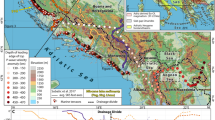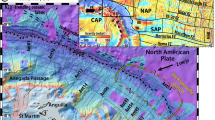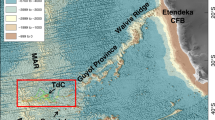Abstract
The global mid-ocean ridge system, where tectonic plates diverge, is traditionally thought of as the largest single volcanic feature on the Earth. Yet, wide expanses of smooth sea floor in the easternmost part of the Southwest Indian Ridge in the Indian Ocean lacks the hummocky morphology that is typical for submarine volcanism. At other slow-spreading ridges, the sea floor can extend by faulting the existing lithosphere, along only one side of the ridge axis. However, the smooth sea floor in the easternmost Southwest Indian Ridge also lacks the corrugated texture created by such faulting. Instead, the sea floor is smooth on both sides of the ridge axis and is thought to be composed of altered mantle-derived rocks. Here we use side-scan sonar to image the sea floor and dredge samples to analyse the composition of two sections of the Southwest Indian Ridge, between 62° 05′ E and 64° 40′ E, where the sea floor formed over the past 11 million years. We show that the smooth floor is almost entirely composed of seawater-altered mantle-derived rocks that were brought to the surface by large detachment faults on both sides of the ridge axis. Faulting accommodates almost 100% of plate divergence and the detachment faults have repeatedly flipped polarity. We suggest that this tectonic process could also explain the exhumation of mantle-derived rocks at the magma-poor margins of rifted continents.
This is a preview of subscription content, access via your institution
Access options
Subscribe to this journal
Receive 12 print issues and online access
$259.00 per year
only $21.58 per issue
Buy this article
- Purchase on Springer Link
- Instant access to full article PDF
Prices may be subject to local taxes which are calculated during checkout





Similar content being viewed by others
References
Dick, H. J. B., Lin, J. & Schouten, H. An ultraslow-spreading class of ocean ridge. Nature 426, 405–412 (2003).
Sauter, D. & Cannat, M. in Diversity of Hydrothermal Systems on Slow-Spreading Ocean Ridges (eds Peter, R., Colin, D., Jérome, D. & Bramley, M.) 153–173 (Geophysical Monograph Series, Vol. 188, AGU, 2010).
Patriat, P., Sloan, H. & Sauter, D. From slow to ultra-slow: A previously undetected event at the Southwest Indian Ridge at ∼ 24 Myr. Geology 36, 207–210 (2008).
Cannat, M. et al. Spreading rate, spreading obliquity, and melt supply at the ultraslow spreading Southwest Indian Ridge. Geochem. Geophys. Geosyst. 9, Q04002 (2008).
Cannat, M., Rommevaux-Jestin, C., Sauter, D., Deplus, C. & Mendel, V. Formation of the axial relief at the very slow spreading Southwest Indian Ridge (49°–69° E). J. Geophys. Res. 104, 22825–22843 (1999).
Sauter, D. et al. From slow to ultra-slow: How does spreading rate affect seafloor roughness and crustal thickness? Geology 39, 911–914 (2011).
Meyzen, C. M., Toplis, M. J., Humler, E., Ludden, J. N. & Mével, C. A discontinuity in mantle composition beneath the southwest Indian Ridge. Nature 421, 731–733 (2003).
Seyler, M., Brunelli, D., Toplis, M. J. & Mével, C. Multiscale chemical heterogeneities beneath the eastern Southwest Indian Ridge (52° E–68° E): Trace element compositions of along axis dredged peridotites. Geochem. Geophys. Geosyst. 12, Q0AC15 (2011).
Seyler, M., Cannat, M. & Mével, C. Evidence for major-element heterogeneity in the mantle source of abyssal peridotites from the Southwest Indian Ridge (52° to 69° E). Geochem. Geophys. Geosyst. 4, 9101 (2003).
Minshull, T. A., Muller, M. R. & White, R. S. Crustal structure of the Southwest Indian Ridge at 66° E: Seismic constraints. Geophys. J. Int. 166, 135–147 (2006).
Mendel, V., Sauter, D., Parson, L. & Vanney, J-R. Segmentation and morphotectonic variations along a super-slow spreading centre: The Southwest Indian Ridge (57° E–70° E). Mar. Geophys. Res. 19, 505–533 (1997).
Sauter, D. et al. Ridge segmentation and the magnetic structure of the Southwest Indian Ridge (at 55°30′ E, 55°30′ E and 66°20′ E): Implications for magmatic processes at ultraslow-spreading centres. Geochem. Geophys. Geosyst. 5, Q05K08 (2004).
Sauter, D. et al. Focused magmatism versus amagmatic spreading along the ultra-slow spreading Southwest Indian Ridge: Evidence from TOBI side scan sonar imagery. Geochem. Geophys. Geosyst. 5, Q10K09 (2004).
Cannat, M. et al. Modes of seafloor generation at a melt-poor ultraslow-spreading ridge. Geology 34, 605–608 (2006).
Snow, J. E. et al. Oblique nonvolcanic seafloor spreading in Lena Trough, Arctic Ocean. Geochem. Geophys. Geosyst. 12, Q10009 (2011).
Sauter, D., Cannat, M. & Mendel, V. Magnetization of 0–26.5 Myr seafloor at the ultraslow spreading Southwest Indian Ridge 61–67° E. Geochem. Geophys. Geosyst. 9, Q04023 (2008).
Searle, R. C. et al. Structure and development of an axial volcanic ridge: Mid-Atlantic Ridge, 45° N. Earth Planet. Sci. Lett. 299, 228–241 (2010).
Cannat, M. et al. Thin crust, ultramafic exposures, and rugged faulting patterns at the Mid-Atlantic Ridge (22°–24° N). Geology 23, 49–52 (1995).
Karson, J. A. et al. Along axis variations in seafloor spreading in the MARK Area. Nature 328, 681–685 (1987).
Dick, H. J. B., Thompson, W. B. & Bryan, W. B. Low angle faulting and steady-state emplacement of plutonic rocks at ridge-transform intersections. EOS Trans. Am. Geophys. Union 62, 406 (1981).
Tucholke, B. E. & Lin, J. A geological model for the structure of ridge segments in slow-spreading ocean crust. J. Geophys. Res. 99, 11937–11958 (1994).
Cann, J. R. et al. Corrugated slip surfaces formed at North Atlantic ridge-transform intersections. Nature 385, 329–332 (1997).
Escartin, J. et al. Central role of detachment faults in accretion of slow-spreading oceanic lithosphere. Nature 455, 790–794 (2008).
Smith, D. K., Cann, J. R. & Escartin, J. Widespread active detachment faulting and core complex formation near 13 degrees N on the Mid-Atlantic Ridge. Nature 442, 440–443 (2006).
MacLeod, C. J. et al. Life cycle of oceanic core complexes. Earth Planet. Sci. Lett. 287, 333–344 (2009).
Hayman, N. W. et al. Oceanic core complex development at the ultraslow spreading Mid-Cayman Spreading Center. Geochem. Geophys. Geosyst. 12, Q0AG02 (2011).
Cheadle, M. & Grimes, C. Structural geology: To fault or not to fault. Nature Geosci. 3, 454–456 (2010).
Lavier, L., Buck, W. R. & Poliakov, A. N. B. Self-consistent rolling-hinge model for the evolution of large-offset low-angle normal faults. Geology 27, 1127–1130 (1999).
Olive, J-A., Behn, M. D. & Tucholke, B. E. The structure of oceanic core complexes controlled by the depth distribution of magma emplacement. Nature Geosci. 3, 491–495 (2010).
Blackman, D. K., Canales, J. P. & Harding, A. Geophysical signatures of oceanic core complexes. Geophys. J. Int. 178, 593–613 (2009).
Escartı´n, J., Mével, C., MacLeod, C. J. & McCaig, A. M. Constraints on deformation conditions and the origin of oceanic detachments: The Mid-Atlantic Ridge core complex at 15° 45′ N. Geochem. Geophys. Geosyst. 4, 1067 (2003).
Reston, T. J. & Ranero, C. R. The 3-D geometry of detachment faulting at mid-ocean ridges. Geochem. Geophys. Geosyst. 12, Q0AG05 (2011).
deMartin, B. J., Sohn, R. A., Pablo Canales, J. & Humphris, S. E. Kinematics and geometry of active detachment faulting beneath the Trans-Atlantic Geotraverse (TAG) hydrothermal field on the Mid-Atlantic Ridge. Geology 35, 711–714 (2007).
MacLeod, C. J., Carlut, J., Escartı´n, J., Horen, H. & Morris, A. Quantitative constraint on footwall rotations at the 15° 45′ N oceanic core complex, Mid-Atlantic Ridge: Implications for oceanic detachment fault processes. Geochem. Geophys. Geosyst. 12, Q0AG03 (2011).
Cannat, M., Sauter, D., Escartı´n, J., Lavier, L. & Picazo, S. Oceanic corrugated surfaces and the strength of the axial lithosphere at slow spreading ridges. Earth Planet. Sci. Lett. 288, 174–183 (2009).
Manatschal, G. et al. The Chenaillet Ophiolite in the French/Italian Alps: An ancient analogue for an oceanic core complex? Lithos 124, 169–184 (2011).
Buck, W. R., Lavier, L. L. & Poliakov, A. N. B. Modes of faulting at mid-ocean ridges. Nature 434, 719–723 (2005).
Minshull, T. A. Geophysical characterization of the ocean-continent transition at magma-poor rifted margins. Comptes Rendus Geosci. 341, 382–393 (2009).
Whitmarsh, R. B., Manatschal, G. & Minshull, T. A. Evolution of magma-poor continental margins from rifting to seafloor spreading. Nature 413, 150–154 (2001).
Welford, J. K. et al. Structure and rifting evolution of the northern Newfoundland Basin from Erable multichannel seismic reflection profiles across the southeastern margin of Flemish Cap. Geophys. J. Int. 180, 976–998 (2010).
Reston, T. J. & McDermott, K. G. Successive detachment faults and mantle unroofing at magma-poor rifted margins. Geology 39, 1071–1074 (2011).
Manatschal, G. et al. What is the tectono-metamorphic evolution of continental break-up: The example of the Tasna Ocean–Continent Transition. J. Struct. Geol. 28, 1849–1869 (2006).
Cannat, M., Manatschal, G., Sauter, D. & Péron-Pinvidic, G. Assessing the conditions of continental breakup at magma-poor rifted margins: What can we learn from slow spreading mid-ocean ridges? Comptes Rendus Geosci. 341, 394–405 (2009).
Flewellen, C., Millard, N. & Rouse, I. TOBI, a vehicle for deep ocean survey. Electron. Commun. Eng. J. 5, 85–93 (1993).
Le Bas, T. P., Mason, D. C. & Millard, N. C. TOBI image processing—the state of the art. IEEE J. Ocean Eng. 20, 85–93 (1995).
Sauter, D. et al. TOBI sidescan sonar imagery of the very slow-spreading Southwest Indian Ridge: Evidence for along axis magma distribution. Earth Planet. Sci. Lett. 1999, 81–95 (2002).
Lavier, L. & Manatschal, G. A mechanism to thin the continental lithosphere at magma-poor margins. Nature 440, 324–238 (2006).
Tucholke, B. E., Behn, M. D., Buck, W. R. & Lin, J. Role of melt supply in oceanic detachment faulting and formation of megamullions. Geology 36, 455–458 (2008).
Acknowledgements
Funding was provided by ANR grant ‘Rift2Ridge’ and support by INSU/CNRS and IPEV. This is IPGP contribution 3370.
Author information
Authors and Affiliations
Contributions
D.S. and M.C. conceived the project and wrote the article. All authors participated in the RV Marion Dufresne MD183 cruise, and contributed to discussions, interpretation of results and manuscript writing.
Corresponding author
Ethics declarations
Competing interests
The authors declare no competing financial interests.
Supplementary information
Supplementary Information
Supplementary Information (PDF 5732 kb)
Rights and permissions
About this article
Cite this article
Sauter, D., Cannat, M., Rouméjon, S. et al. Continuous exhumation of mantle-derived rocks at the Southwest Indian Ridge for 11 million years. Nature Geosci 6, 314–320 (2013). https://doi.org/10.1038/ngeo1771
Received:
Accepted:
Published:
Issue Date:
DOI: https://doi.org/10.1038/ngeo1771
This article is cited by
-
Geophysical investigation of the Mado Megamullion oceanic core complex: implications for the end of back-arc spreading
Progress in Earth and Planetary Science (2023)
-
Microseismicity and lithosphere thickness at a nearly-amagmatic oceanic detachment fault system
Nature Communications (2023)
-
Towards a process-based understanding of rifted continental margins
Nature Reviews Earth & Environment (2023)
-
Sulfide metallogenic model for the ultraslow-spreading Southwest Indian Ridge
Science China Earth Sciences (2023)
-
Trace elements in abyssal peridotite olivine record melting, thermal evolution, and melt refertilization in the oceanic upper mantle
Contributions to Mineralogy and Petrology (2023)



